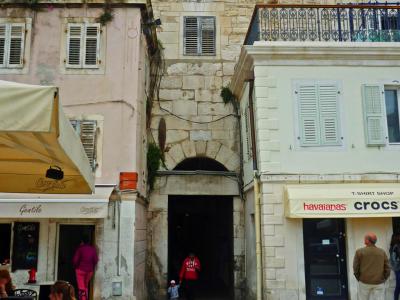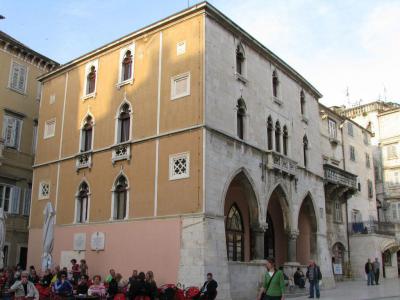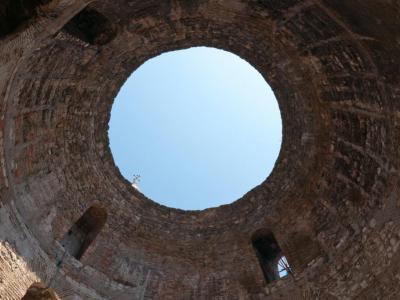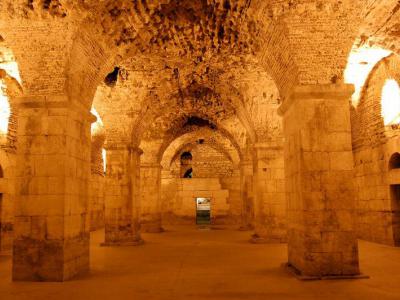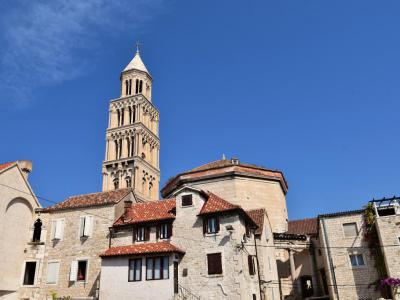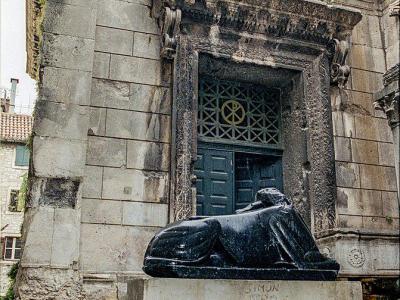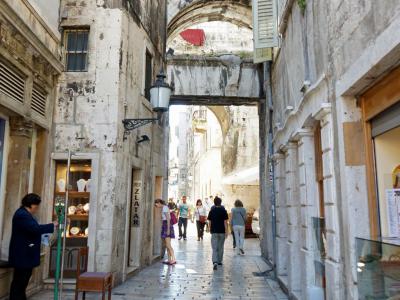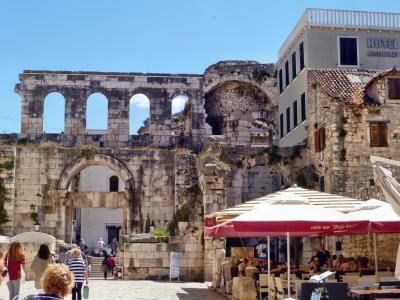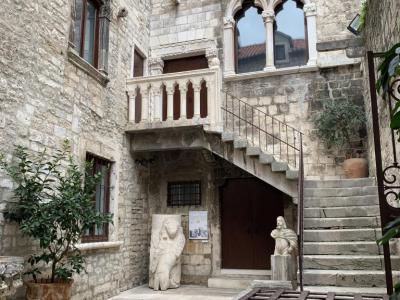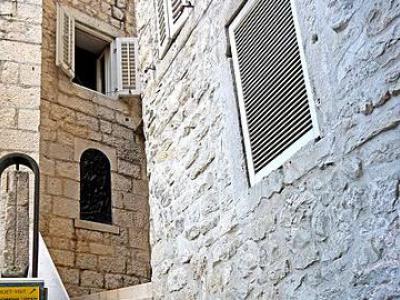Diocletian Palace Tour (Self Guided), Split
One of the best preserved monuments of the Roman architecture in the world, Diocletian's Palace was built for the Emperor Diocletian, at the turn of the 4th century AD, as his retirement home. Massive and resembling a fortress rather, it represents a combination of a luxury villa and a military garrison, and is divided into four parts by two main streets. Integral of the historic core of Split, the complex comprises nearly half of the Old Town, and was listed as a UNESCO World Heritage Site in 1979.
Over the centuries, the inhabitants of the palace and citizens of Split have adapted parts of it to their own needs, causing drastic changes to both the interior and the exterior, whilst the outlines of the original structure remain visible. Here you will find not only antiquities, but also elements from the Medieval, Renaissance, and Baroque time periods.
Among the key landmarks here are:
Golden Gate – “Porta Septemtrionalis”; the main entrance built in the shape of a rectangle and decorated with niches containing figure sculptures of the four tetrarchs: Diocletian, Maximian, Galerius and Constantius Chlorus.
Vestibule – a rotunda with a missing dome with excellent acoustics. In the old days the place was used to impress the visiting ambassadors.
Cellars of Diocletian's Palace - a place to store wine and food for the use of the Palace. Today the cellar hosts a popular indoor market.
Cathedral of St. Domnius – former Mausoleum of the Roman Emperor, persecutor of Christians; holds relics of St Domnius and St Anastasius, martyrs executed in the nearby Solin.
For a closer acquaintance with the Diocletian Palace and its artifacts, take this self-guided walking tour.
Over the centuries, the inhabitants of the palace and citizens of Split have adapted parts of it to their own needs, causing drastic changes to both the interior and the exterior, whilst the outlines of the original structure remain visible. Here you will find not only antiquities, but also elements from the Medieval, Renaissance, and Baroque time periods.
Among the key landmarks here are:
Golden Gate – “Porta Septemtrionalis”; the main entrance built in the shape of a rectangle and decorated with niches containing figure sculptures of the four tetrarchs: Diocletian, Maximian, Galerius and Constantius Chlorus.
Vestibule – a rotunda with a missing dome with excellent acoustics. In the old days the place was used to impress the visiting ambassadors.
Cellars of Diocletian's Palace - a place to store wine and food for the use of the Palace. Today the cellar hosts a popular indoor market.
Cathedral of St. Domnius – former Mausoleum of the Roman Emperor, persecutor of Christians; holds relics of St Domnius and St Anastasius, martyrs executed in the nearby Solin.
For a closer acquaintance with the Diocletian Palace and its artifacts, take this self-guided walking tour.
How it works: Download the app "GPSmyCity: Walks in 1K+ Cities" from Apple App Store or Google Play Store to your mobile phone or tablet. The app turns your mobile device into a personal tour guide and its built-in GPS navigation functions guide you from one tour stop to next. The app works offline, so no data plan is needed when traveling abroad.
Diocletian Palace Tour Map
Guide Name: Diocletian Palace Tour
Guide Location: Croatia » Split (See other walking tours in Split)
Guide Type: Self-guided Walking Tour (Sightseeing)
# of Attractions: 11
Tour Duration: 1 Hour(s)
Travel Distance: 0.6 Km or 0.4 Miles
Author: DanaOffice
Sight(s) Featured in This Guide:
Guide Location: Croatia » Split (See other walking tours in Split)
Guide Type: Self-guided Walking Tour (Sightseeing)
# of Attractions: 11
Tour Duration: 1 Hour(s)
Travel Distance: 0.6 Km or 0.4 Miles
Author: DanaOffice
Sight(s) Featured in This Guide:
- Bronze Gate
- Ethnographic Museum
- Vestibule
- Podrum (Cellars of Diocletian's Palace)
- Cathedral of St. Domnius
- Temple of Jupiter
- Iron Gate and Church of Our Lady of the Bell Tower
- Silver Gate
- City Museum of Split
- Church of Saint Martin
- Golden Gate
1) Bronze Gate
The Bronze gate (Mjedena vrata) was originally Porta Meridionalis, the "southern gate". It is unlike the other Roman gates. It is small, plain, no ornament. There are no flanking gatehouses. It gave direct access to the sea and served as an emergency exit in the event of an attack from the land. In the middle ages it was the "security gate."
In Diocletian's time there was no promenade outside the gate. The sea lapped against the south wall. The emperor was able to enter the compound directly by ship. Today it serves as the entry from the promenade to the Cathedral. Since it has access to the Riva, it is currently the most used gate of the palace. Many guided or self-guided tours start here.
The emperor could enter the Palace directly from the sea. His private apartments are in the southern half of the complex. Naturally this meant the more luxurious appointments would be in the southern half, below the decumanus road running east to west.
In Diocletian's time there was no promenade outside the gate. The sea lapped against the south wall. The emperor was able to enter the compound directly by ship. Today it serves as the entry from the promenade to the Cathedral. Since it has access to the Riva, it is currently the most used gate of the palace. Many guided or self-guided tours start here.
The emperor could enter the Palace directly from the sea. His private apartments are in the southern half of the complex. Naturally this meant the more luxurious appointments would be in the southern half, below the decumanus road running east to west.
2) Ethnographic Museum
The Ethnographic Museum (Etnografski muzej) is a smaller museum concentrating on a wide selection of ethnographic content. The Museum was founded in 1910. It collects both indigenous and contemporary materials focusing on Dalmatia.
Dalmatian clothing, embroidery, knitting and samples of trade items are here. Wood carving, pottery, weapons and jewelry are exhibited. Examples of fine lace from the islands of Pag and Hvar are also shown.
The museum is located next to the peristyle, the center of the imperial complex. The seventh century Church of Saint Andrew de Fenestris is on the ground floor of the museum. It shares space with the bedrooms of the emperor Diocletian. One may, from here, climb the staircase leading to the Renaissance terrace atop the Vestibule for amazing views.
The museum is not about the great movers and shakers of history. Attention is given mainly to the lives and activities of ordinary people throughout the ages in the Dalmation area. There is a small admission charge but there is a discount with a Split Card.
Dalmatian clothing, embroidery, knitting and samples of trade items are here. Wood carving, pottery, weapons and jewelry are exhibited. Examples of fine lace from the islands of Pag and Hvar are also shown.
The museum is located next to the peristyle, the center of the imperial complex. The seventh century Church of Saint Andrew de Fenestris is on the ground floor of the museum. It shares space with the bedrooms of the emperor Diocletian. One may, from here, climb the staircase leading to the Renaissance terrace atop the Vestibule for amazing views.
The museum is not about the great movers and shakers of history. Attention is given mainly to the lives and activities of ordinary people throughout the ages in the Dalmation area. There is a small admission charge but there is a discount with a Split Card.
3) Vestibule
Occasionally, a klapa ensemble will meet in the Vestibule of the Palace of Diocletian. They are there to practice their traditional a cappella singing called "Klapa". Their harmonies resound within the circular vault of the rotunda. One can imagine even the restless ghost of the emperor stops to listen.
The Vestibule is a rotunda with a missing dome. Where the dome should be is a perfect circle of blue sky. It reminds one of the smoke holes in the ancient pagan temples. Today, instead of smoke from sacrificial fires, melodies escape to the open air.
Like an atrium, the Vestibule is the first part of the hall in the Palace leading from the peristyle to the imperial apartments. The Vestibule was designed to be an impressive reception hall for distinguished visitors and ambassadors.
But why do the Klapa groups meet in the Vestibule? The acoustics! The rounded walls resonate like a drum.
The Vestibule is a rotunda with a missing dome. Where the dome should be is a perfect circle of blue sky. It reminds one of the smoke holes in the ancient pagan temples. Today, instead of smoke from sacrificial fires, melodies escape to the open air.
Like an atrium, the Vestibule is the first part of the hall in the Palace leading from the peristyle to the imperial apartments. The Vestibule was designed to be an impressive reception hall for distinguished visitors and ambassadors.
But why do the Klapa groups meet in the Vestibule? The acoustics! The rounded walls resonate like a drum.
4) Podrum (Cellars of Diocletian's Palace)
Under Diocletian's apartments were the cellars. Strong substructures which were used to support the apartments above and to store wine, foods and other items for the use of the Palace. The supports were a faithful copy of the structures above. The cellars also had a nymphaeum, a shrine dedicated to the nymphs guarding a source of fresh water.
In the middle ages the palace gradually became a safe haven for refugees. Part of the vast underground area was residential. In later times wealthier citizens who had houses above the cellars would break through the vaults and turn them into storage spaces for themselves.
Today Diocletian's cellars can be reached through the Bronze Gate, or through a stair connected to the peristyle. The western part of the cellars is preserved. It is available to sightseers and is used as a fair and exhibition space. The collapsed eastern part is being restored and will one day be accessible as well.
In the middle ages the palace gradually became a safe haven for refugees. Part of the vast underground area was residential. In later times wealthier citizens who had houses above the cellars would break through the vaults and turn them into storage spaces for themselves.
Today Diocletian's cellars can be reached through the Bronze Gate, or through a stair connected to the peristyle. The western part of the cellars is preserved. It is available to sightseers and is used as a fair and exhibition space. The collapsed eastern part is being restored and will one day be accessible as well.
5) Cathedral of St. Domnius (must see)
It was the year 305. Roman emperor Diocletian had persecuted a lot of Christians and like-minded dissidents in his Imperial tour of duty. Now it was time to retire to his native land of Dalmatia and raise vegetables. As the vegetables were growing, he built a mausoleum. His final resting place was in the center of Split. But he would not rest there forever.
By the seventh century the Cathedral of Saint Domnius was consecrated. The Cathedral was in fact the Mausoleum of Diocletian. Those darn Christians finally got him. The Cathedral is a cluster of ad-ons that have changed little over the years. The former Mausoleum is dedicated to the Virgin Mary. The bell tower, added in 1100, is dedicated to Saint Domnius.
Saint Domnius is the patron saint of Split. He was the Bishop of Salona, a Roman city and capital of Dalmatia. He was born in Antioch and he was beheaded, along with seven other Christians, in 304. Ironically, he died one year before Diocletian retired.
Diocletian was a soldier. Naturally his retirement home was a Roman army camp. There was an East-West road (decumanus) and a North-South road (cardo maximus). Those roads remain in Split today. At the intersection of the roads is a great peristyle which grants access from the east to the Cathedral of Saint Domnius.
The Cathedral evolved through three stages. Diocletian's Mausolem, the central part of the cathedral, dates from the end of the third century. It is composed of white marble, limestone, and brick. In the seventh century a choir was added to the mausoleum. Finally the bell tower was erected in 1100. There was further rebuilding in 1908.
Within the Church there are relics and art treasures. Found here is the 13th century panel Painting, Madonna and Child. There are reliquaries, chalices and vestments from the 13th to the 19th centuries. The library includes the Book of gospels (6th century), Kartularium from Sumpetar (11th century) and the Historia Salanitana (13th century).
Why You Should Visit:
To take in the ancient, medieval and modern Split all in one place.
By the seventh century the Cathedral of Saint Domnius was consecrated. The Cathedral was in fact the Mausoleum of Diocletian. Those darn Christians finally got him. The Cathedral is a cluster of ad-ons that have changed little over the years. The former Mausoleum is dedicated to the Virgin Mary. The bell tower, added in 1100, is dedicated to Saint Domnius.
Saint Domnius is the patron saint of Split. He was the Bishop of Salona, a Roman city and capital of Dalmatia. He was born in Antioch and he was beheaded, along with seven other Christians, in 304. Ironically, he died one year before Diocletian retired.
Diocletian was a soldier. Naturally his retirement home was a Roman army camp. There was an East-West road (decumanus) and a North-South road (cardo maximus). Those roads remain in Split today. At the intersection of the roads is a great peristyle which grants access from the east to the Cathedral of Saint Domnius.
The Cathedral evolved through three stages. Diocletian's Mausolem, the central part of the cathedral, dates from the end of the third century. It is composed of white marble, limestone, and brick. In the seventh century a choir was added to the mausoleum. Finally the bell tower was erected in 1100. There was further rebuilding in 1908.
Within the Church there are relics and art treasures. Found here is the 13th century panel Painting, Madonna and Child. There are reliquaries, chalices and vestments from the 13th to the 19th centuries. The library includes the Book of gospels (6th century), Kartularium from Sumpetar (11th century) and the Historia Salanitana (13th century).
Why You Should Visit:
To take in the ancient, medieval and modern Split all in one place.
6) Temple of Jupiter
In the western part of Diocletian's Palace, near the peristyle, is the Temple of Jupiter. It was built around the year 300 and became a baptistery of Saint John the Baptist in the sixth century. Before the entrance there is one of the twelve sphinxes brought from Egypt by the Emperor Diocletian.
The Temple of Jupiter was dedicated to Jupiter, the Roman Zeus, who was considered to be the emperor's "divine father." Parts of the Palace remained unfinished when Son of Zeus arrived unexpectedly after his hasty abdication. Reliefs of heroes and lesser gods are above the entrance. They are Victoria, Triton, Helios, Hercules, and Apollo.
The gods are followed by the saints. Sarcophagi of Ivan of Ravenna and Lovre, two early archbishops of Split, are inside the Temple. Saint John the Baptist makes his appearance in the form of a large bronze statue by Ivan Mestrovic. In the 11th century a Romanesque bell tower was installed over the vault.
In 1907 a few houses that were impinging on the sides of the Temple were demolished, freeing the Temple of attachments.
The Temple of Jupiter was dedicated to Jupiter, the Roman Zeus, who was considered to be the emperor's "divine father." Parts of the Palace remained unfinished when Son of Zeus arrived unexpectedly after his hasty abdication. Reliefs of heroes and lesser gods are above the entrance. They are Victoria, Triton, Helios, Hercules, and Apollo.
The gods are followed by the saints. Sarcophagi of Ivan of Ravenna and Lovre, two early archbishops of Split, are inside the Temple. Saint John the Baptist makes his appearance in the form of a large bronze statue by Ivan Mestrovic. In the 11th century a Romanesque bell tower was installed over the vault.
In 1907 a few houses that were impinging on the sides of the Temple were demolished, freeing the Temple of attachments.
7) Iron Gate and Church of Our Lady of the Bell Tower
The West gate, or Iron Gate is one of four gates giving access/egress to the palace of Diocletian. It is part of an urban complex of the People's Square (Pjaca), the old City Hall, the clock tower, and the Nakic, Karepic, Cambi, and Cipriani palaces.
The arrangements around the Iron Gate include ancient developments like the defensive rampart, with its double door safety chamber and the Church of Our Lady of the Bell Tower. The church is a tiny, narrow space similar to the churches in the other gates. It was renovated when the bell tower was added in the 11th century.
On the northern wall of the rampart, behind a sealed medieval niche, a sculpture of hands holding a crown was discovered. It was restored and returned to the niche.
The arrangements around the Iron Gate include ancient developments like the defensive rampart, with its double door safety chamber and the Church of Our Lady of the Bell Tower. The church is a tiny, narrow space similar to the churches in the other gates. It was renovated when the bell tower was added in the 11th century.
On the northern wall of the rampart, behind a sealed medieval niche, a sculpture of hands holding a crown was discovered. It was restored and returned to the niche.
8) Silver Gate
There are four gates to the stari grad ("old town"). The Silver Gate faces east, in the direction of the Roman town, Epetia. Since the gate was meant to face east, the Romans called it Porta Orientalis, the "eastern gate." The other three gates to Diocletian's retirement retreat are called, "Golden Gate", "Iron Gate", and "Bronze Gate."
Around the sixth century, above the gate in a narrow corridor a mini-church of Saint Apolinar was built. This occurred at the time of a flood of refugees from outside the walls. Similar mini-churches were established above the other gates. In the 18th century the ruling Venetians opened a "small gate" next to the Silver Gate.
Opposite the Silver Gate by a market is the monastery and church of Saint Catherine of Alexandria built by the Dominicans in the 17th century.
On his way to visit the Cathedral of Saint Dmnius in 2000, Pope John Paul II drove through the Silver Gate in his Popemobile.
Around the sixth century, above the gate in a narrow corridor a mini-church of Saint Apolinar was built. This occurred at the time of a flood of refugees from outside the walls. Similar mini-churches were established above the other gates. In the 18th century the ruling Venetians opened a "small gate" next to the Silver Gate.
Opposite the Silver Gate by a market is the monastery and church of Saint Catherine of Alexandria built by the Dominicans in the 17th century.
On his way to visit the Cathedral of Saint Dmnius in 2000, Pope John Paul II drove through the Silver Gate in his Popemobile.
9) City Museum of Split
Established in 1946, the City Museum of Split is located in the northeastern part of the Diocletian Palace, within the complex of Medieval buildings centered around a remarkable Gothic-Renaissance edifice which once belonged to the noble family of Papalic. The family's coat of arms is featured on one of the portals.
The Papalic Palace (Papaliceva Palaca) was designed and built by the native master Juraj of Dalmatia (Juraj Dalmatinac) in the 15th century. The beautifully executed courtyard has richly decorated portal and loggia. The Renaissance hall with a fine window decoration and a well preserved wooden ceiling completes the courtyard ensemble.
The museum is found on the first floor. Inside, its permanent collection features artifacts and a variety of sculptures, dating from the Diocletian times, through the 12th-14th centuries, when Split was an autonomous commune, and more. Among the exhibits there are pieces of medieval weaponry, various paintings and artworks, along with fragments of sculptures, monuments and statues that were once part of the buildings in Split. The dining room, on the first floor, is furnished just as it was back in the day, when the Papalic family owned the house, giving the idea of how the nobility of that time lived.
Here you will also find the city statute, seal and coins, plus the Romanesque sculpture from the belfry of the local cathedral attributed to the period of Venetian rule (15th- 16th centuries). There are also numerous documents, photographs, maps and manuscripts relating to the more recent history of Split.
Additionally, within the museum there is a gallery of Emanuel Vidovic, a major local painter of the 20th century and one of the foremost protagonists of Croatian modern painting.
The Papalic Palace (Papaliceva Palaca) was designed and built by the native master Juraj of Dalmatia (Juraj Dalmatinac) in the 15th century. The beautifully executed courtyard has richly decorated portal and loggia. The Renaissance hall with a fine window decoration and a well preserved wooden ceiling completes the courtyard ensemble.
The museum is found on the first floor. Inside, its permanent collection features artifacts and a variety of sculptures, dating from the Diocletian times, through the 12th-14th centuries, when Split was an autonomous commune, and more. Among the exhibits there are pieces of medieval weaponry, various paintings and artworks, along with fragments of sculptures, monuments and statues that were once part of the buildings in Split. The dining room, on the first floor, is furnished just as it was back in the day, when the Papalic family owned the house, giving the idea of how the nobility of that time lived.
Here you will also find the city statute, seal and coins, plus the Romanesque sculpture from the belfry of the local cathedral attributed to the period of Venetian rule (15th- 16th centuries). There are also numerous documents, photographs, maps and manuscripts relating to the more recent history of Split.
Additionally, within the museum there is a gallery of Emanuel Vidovic, a major local painter of the 20th century and one of the foremost protagonists of Croatian modern painting.
Image Courtesy of Roger.
10) Church of Saint Martin
Hiding in a tiny guard space above the Golden Gate Of Diocletian's Palace is the church of Saint Martin. Currently managed by the Dominican sisters, it is famous for its 11th century chancel screen. The church is open to visitors for a nominal fee. The space became a mini-church sometime in the sixth century during an inundation of refugees.
Churches similar to Saint Martin's exist or did exist over the Silver gate, Iron Gate, and Bronze Gate. The main altar dates from the ninth century. In the 14th century the Church made a settlement for Dominican sisters who care for Saint Martin's.
In 1929 a tablet was found in one of the closed up windows. It bore the inscription, "The unworthy servant, priest Dominic..." It was theorized this might be the gravestone of Dominic, but no remains have been found.
Just as one Gate had niches for the successors in empire, the other gates came to honor saints. Saint Theodore was for the West Gate, Saint Apollinaris for the East Gate, and Saint Julian for the South Gate.
The altar screen is of marble. the screen is covered with depictions of grape vines and griffins. On the wall is an inscription marking the patronage of the Virgin, Saint Gregory, the Pope and Saint Martin.
Churches similar to Saint Martin's exist or did exist over the Silver gate, Iron Gate, and Bronze Gate. The main altar dates from the ninth century. In the 14th century the Church made a settlement for Dominican sisters who care for Saint Martin's.
In 1929 a tablet was found in one of the closed up windows. It bore the inscription, "The unworthy servant, priest Dominic..." It was theorized this might be the gravestone of Dominic, but no remains have been found.
Just as one Gate had niches for the successors in empire, the other gates came to honor saints. Saint Theodore was for the West Gate, Saint Apollinaris for the East Gate, and Saint Julian for the South Gate.
The altar screen is of marble. the screen is covered with depictions of grape vines and griffins. On the wall is an inscription marking the patronage of the Virgin, Saint Gregory, the Pope and Saint Martin.
11) Golden Gate
When Diocletian retired he left the empire behind him. He sailed to his sea front villa/fortress. He debarked and entered his palace through the Porta septemrionalis. Or, as some prefer to say The Golden Gate. The gate was designed with double doors for defensive tactics. Or, as some would say then, "propugnaculum."
The Golden Gate ("Zlatna vrata") is one of four gates giving access and egress to the old town ("stari grad"). The old town of course was Diocletian's Palace itself. In the Emperor's time the gate was referred to as "the northern gate". In the middle ages it was known as "Roman Gate." The name Golden Gate was first used in 1553.
On each side of the gate are niches for the statues of the four Tetrarchs, Diocletian himself, and the rulers of the divided Empire, Maximian, Galerius, and Constantius Chlorus. The sixth century church of Saint Martin's is perched above the outer part of the gate.
Most visitors arriving from the harbor side of the Palace will enter through the the South or East Gates although the North Gate, the Golden Gate, was meant to be the main entrance. Today the 28 foot statue by Ivan Mestrovic of Grgur Ninski, Saint Gregory of Nin, looms just outside the Golden Gate.
The Golden Gate ("Zlatna vrata") is one of four gates giving access and egress to the old town ("stari grad"). The old town of course was Diocletian's Palace itself. In the Emperor's time the gate was referred to as "the northern gate". In the middle ages it was known as "Roman Gate." The name Golden Gate was first used in 1553.
On each side of the gate are niches for the statues of the four Tetrarchs, Diocletian himself, and the rulers of the divided Empire, Maximian, Galerius, and Constantius Chlorus. The sixth century church of Saint Martin's is perched above the outer part of the gate.
Most visitors arriving from the harbor side of the Palace will enter through the the South or East Gates although the North Gate, the Golden Gate, was meant to be the main entrance. Today the 28 foot statue by Ivan Mestrovic of Grgur Ninski, Saint Gregory of Nin, looms just outside the Golden Gate.
Walking Tours in Split, Croatia
Create Your Own Walk in Split
Creating your own self-guided walk in Split is easy and fun. Choose the city attractions that you want to see and a walk route map will be created just for you. You can even set your hotel as the start point of the walk.
Marjan Hill Walking Tour
Marjan Hill is a picturesque natural wonder – a unique landform – located on the Split peninsula in Croatia. The majestic hill (or the low mountain, if you like) is surrounded by the sea and the city, and represents the green oasis ideal for walks, excursions, and rock climbing. Visitors to the area are greeted with a plethora of sights catering to various interests and equally enjoyed by... view more
Tour Duration: 1 Hour(s)
Travel Distance: 1.4 Km or 0.9 Miles
Tour Duration: 1 Hour(s)
Travel Distance: 1.4 Km or 0.9 Miles
Split Introduction Walking Tour
Split is the largest city in Dalmatia. It is a regional transport center, a tourist magnet, and the ancient dacha of the Roman emperor Diocletian. Like most other cities of the Mediterranean, it started out as a Greek colony. The original name was Aspalatos.
Supposedly, the city owes its name to the word for "spiny broom." Which spiny broom is not clear, but history has many such... view more
Tour Duration: 1 Hour(s)
Travel Distance: 1.2 Km or 0.7 Miles
Supposedly, the city owes its name to the word for "spiny broom." Which spiny broom is not clear, but history has many such... view more
Tour Duration: 1 Hour(s)
Travel Distance: 1.2 Km or 0.7 Miles
The Most Popular Cities
/ view all



